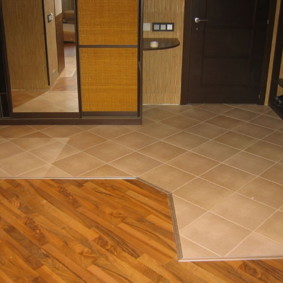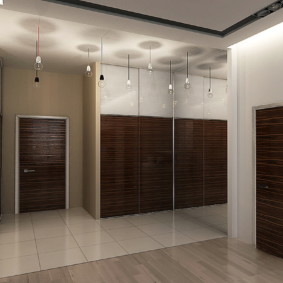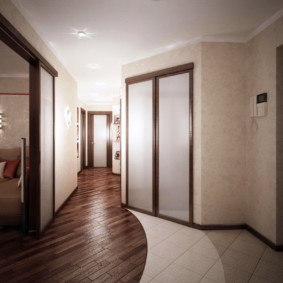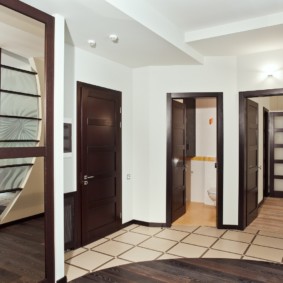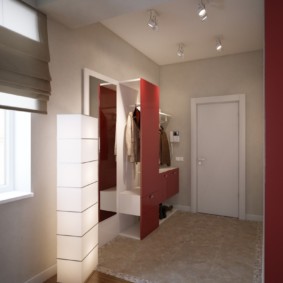 Hallway
Choose an interesting style when decorating the hallway
Hallway
Choose an interesting style when decorating the hallway
Having chosen the option of decorating the walls and ceiling in the hallway, do not forget about the finish of the floor. It should not only correspond to the general interior solution, but also be convenient and functional. Tile and laminate flooring in the hallway, on their own or in a duet, is an excellent option.

Modern flooring is like art.
Tile or Laminate
Content
Recently, debates about what material to use for the floor of the hallway are getting hotter. For some, the tiles in the corridor is our everything. And others believe that the hallway should be warmer and more comfortable, which means that the laminate is the ideal covering.

It is important to choose the right material for practical reasons.
In fact, both tiles and floor coverings have their own advantages and disadvantages. Therefore, a clear answer to the question: which is better? - it can not be. Tiles are valued for their durability, aesthetic appearance and ease of maintenance.

The flooring should be outwardly attractive, fitting into the style of the interior.
Almost the same is said about the laminate, adding that it is also cheaper. And in the end, it all depends on personal preferences: who likes what more. Perhaps that is why a compromise was found - a combination.

This solution is especially relevant for the hallway - the place where the floor is most susceptible to moisture and pollution.
Combining materials: advantages and disadvantages
Repair is a long process and requires moral and physical efforts. Therefore, I really want the result not to disappoint. A variety of materials are available today. They differ in color, texture, price. But in such a variety, it is easier to choose an option that meets all the requirements, or is ideally suited for combination in one form or another.

Today, the approach to floor design is more demanding than before.
Tiles and laminate, at first glance, “polar” materials that have nothing in common, perfectly combine with each other, creating interesting and comfortable options for finishing the floor. The tile is cold and hard, and the laminate, on the contrary, is warm and “lively” material.

The flooring should be attractive, reliable, easy to care for and perfectly preserve the beauty of appearance.
Experts recommend using tiles for a specific area of the floor in the hallway, and leave the rest of the space under the laminate. Both tile and laminate have a long service life and are easy to use - this is the very unifying factor that cannot but rejoice.

Tiles and laminate look good together, and it is difficult to choose the best type of material for the hallway.
The benefits of combining.
- Practicality and convenience. “Plots” of tiles and coatings are at your discretion, ensuring maximum comfort for yourself.
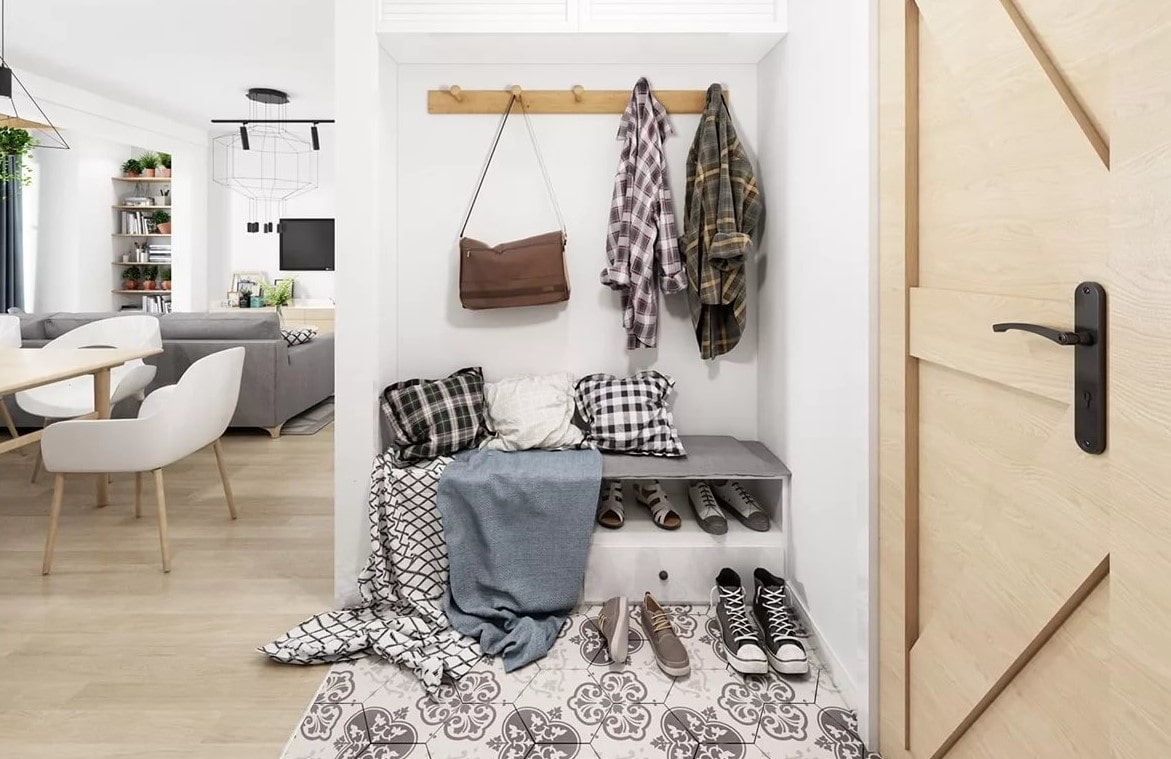
The combination of tiles and laminate can be called the golden mean in the design of the floor.
- Creating a unique interior. After all, since you are combining, no one will do it.

Combination allows zoning of the hallway space, contributing to the organization of each site.
- The possibility of creating several zones in one hallway: a dressing room, a place for shoes, a dressing room and so on.
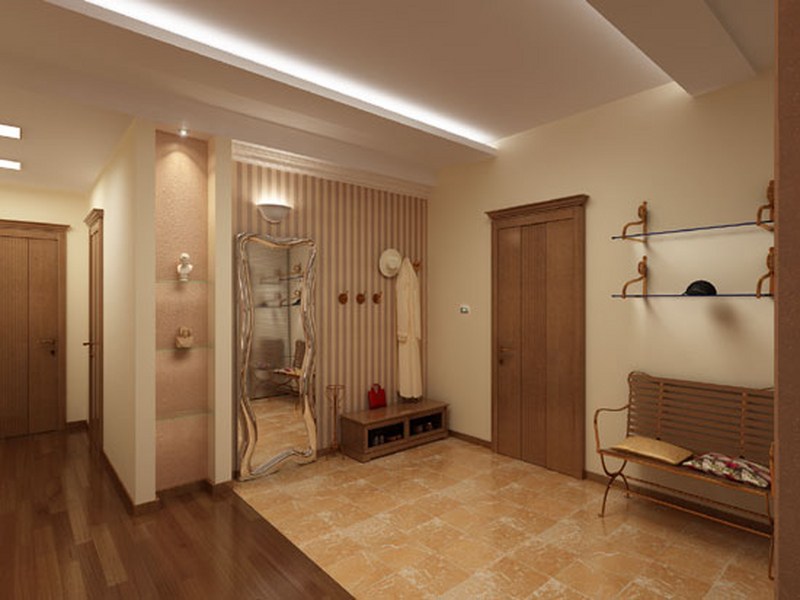
You can beat the lack of usable space by visually increasing the space.
- Laminate is a cheaper material than tile, so combining it will save the budget.

The lining method allows for areas with greater traffic to choose a more durable material, resistant to abrasion and weight load.
- A large selection of colors and textures creates the perfect combination of materials.

By combining the power to make the flooring fashionable, pleasant and homely, simulating a different type of surface.
- Environmental friendliness.

Such a floor will be able to bring its own zest to the interior, bringing together disparate objects of the existing environment.
- Proper combination increases the modest dimensions of the hallway.

The combination of tile and laminate is a combination of reliability, quality and durability.
Disadvantages.
- The main problem is the quality processing of the junction of tiles and laminate.
- Laminate is unstable to moisture, unlike tiles.
- The difficulty of laying tiles. Usually, this has to be entrusted to professional masters; it can’t do it on its own without special skills.

Both materials used are quality flooring. Combining them is a bold and fashionable design technique.
However, all the flaws are nullified, at the sight of an amazing result of a combination of such dissimilar materials.

Harmoniously fits into a different style of interior, regardless of direction, whether classic, modern or ethnic.
The junction of tiles and laminate in the hallway is made out in different ways.
- Molding. This is a kind of nut. Indispensable when the surfaces are slightly different in height. The molding is made in a straight and curved version, so fragments of different coatings can have an arbitrary shape. Aluminum moldings are recognized as the highest quality, but they are not suitable for every interior. Alternatively, choose plastic or wooden counterparts.
- Cork compensator. One of the best options for "leveling" the transition. And the availability of compensators of different colors allows you to choose the most suitable option for any surface.
- Butt fastening. Usually this option is used for small rooms, when the use of additional elements "steals" the space. This method requires professional skills and a very neat approach.
- Construction sealant and foam. Budget and easy to implement option. The only downside is that dismantling is subsequently impossible. Work will also require accuracy, since the sealant will spoil it hopelessly on contact with the surface.

This design is appropriate in premises of various types: residential apartments, country houses, cottages, offices, studios, industrial premises.
Combination Rules
When choosing a color, we take into account the following: light tones visually increase the space, dark tones hide it. The ideal color scheme for a small room is white. But since the hallway is not the right place for snow-white variations, choose a beige, light brown or even peach shade for a small corridor.

Finishing brings style to boring interiors made in a single color scheme, paying attention to the sophistication of the design solution.
With proper combination of the floor in the hallway, the space is arranged in such a way that the brightest sections of the room will not come in contact with dirty shoes, outerwear or umbrellas.

This combination is an excellent solution for the design of flooring in any interior.
A large entrance hall is a godsend for designers. It embodies the most daring and unusual ideas. Only one rule is required: walls are lighter than the floor. A bright floor perfectly complements the walls of any light shade.

Both materials are convenient in that they make it possible to perform facing the design features of the room without problems.
To make the combined floor look successful, the following recommendations are given.
- You should buy tile and laminate at the same time to immediately see how these two materials look together.An error of even one tone in the color scheme will be noticeable and spoil the overall impression.

Laying tiles and laminate provides a smooth surface, so the appearance of the floor is always impeccable.
- Both laminate and ceramics look better in neutral colors. In addition, if you are not a professional designer, this choice will be a win-win.

Well thought-out design matters.
- If you crave contrast, then choose a tile of a bright shade, and the flooring is neutral.

The process of decorating the floor is quite time-consuming: it is important to calculate each tile fragment, its location relative to the intended pattern.
By the way, if you consider yourself a lover of warmth and comfort, make the floor in the hallway warm. Today, such technologies are common and do not require serious investments. This will compensate for the “coldness” of the tile and make the hallway cozy and comfortable.

It is worth choosing a moisture resistant laminate made according to a special production technology.
So, the choice of material and professional finishing work is the guarantee that your hallway will be unique in its kind, convenient and functional. And the floor in the hallway, combined from different materials, will make even a small space interesting and creative.

The success of the choice is the simultaneous purchase of two materials: it is better to see how they fit together.
VIDEO: How to properly arrange the joint of tiles and laminate.




